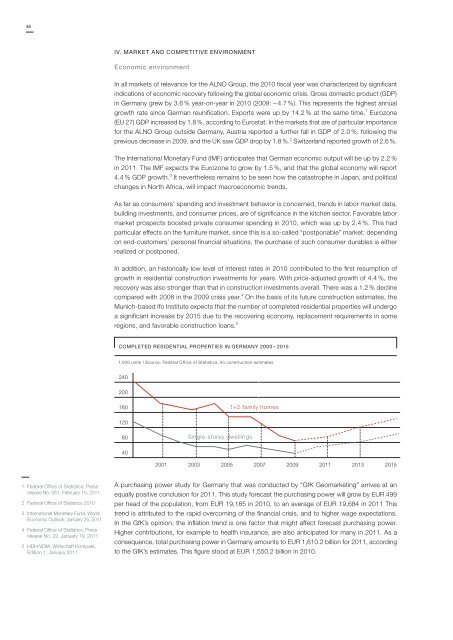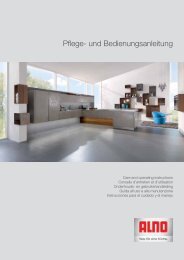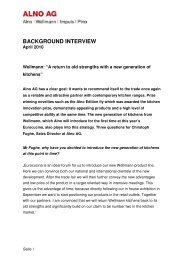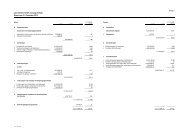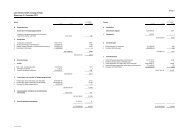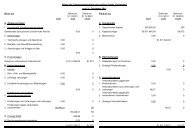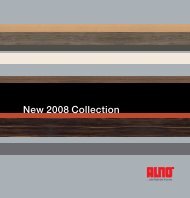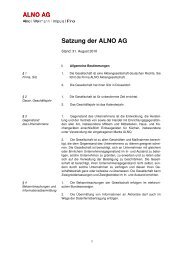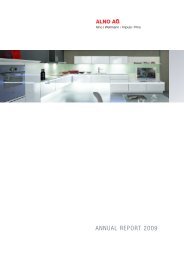100 % FUTURE - ALNO
100 % FUTURE - ALNO
100 % FUTURE - ALNO
You also want an ePaper? Increase the reach of your titles
YUMPU automatically turns print PDFs into web optimized ePapers that Google loves.
46<br />
IV. MARKET AND COMPETITIVE ENVIRONMENT<br />
Economic environment<br />
In all markets of relevance for the <strong>ALNO</strong> Group, the 2010 fiscal year was characterized by significant<br />
indications of economic recovery following the global economic crisis. Gross domestic product (GDP)<br />
in Germany grew by 3.6 % year-on-year in 2010 (2009: – 4.7 %). This represents the highest annual<br />
growth rate since German reunification. Exports were up by 14.2 % at the same time. 1 Eurozone<br />
(EU 27) GDP increased by 1.8 %, according to Eurostat. In the markets that are of particular importance<br />
for the <strong>ALNO</strong> Group outside Germany, Austria reported a further fall in GDP of 2.0 %, following the<br />
previous decrease in 2009, and the UK saw GDP drop by 1.8 %. 2 Switzerland reported growth of 2.6 %.<br />
The International Monetary Fund (IMF) anticipates that German economic output will be up by 2.2 %<br />
in 2011. The IMF expects the Eurozone to grow by 1.5 %, and that the global economy will report<br />
4.4 % GDP growth. 3 It nevertheless remains to be seen how the catastrophe in Japan, and political<br />
changes in North Africa, will impact macroeconomic trends.<br />
As far as consumers’ spending and investment behavior is concerned, trends in labor market data,<br />
building investments, and consumer prices, are of significance in the kitchen sector. Favorable labor<br />
market prospects boosted private consumer spending in 2010, which was up by 2.4 %. This had<br />
particular effects on the furniture market, since this is a so-called “postponable” market: depending<br />
on end-customers’ personal financial situations, the purchase of such consumer durables is either<br />
realized or postponed.<br />
In addition, an historically low level of interest rates in 2010 contributed to the first resumption of<br />
growth in residential construction investments for years. With price-adjusted growth of 4.4 %, the<br />
recovery was also stronger than that in construction investments overall. There was a 1.2 % decline<br />
compared with 2008 in the 2009 crisis year. 4 On the basis of its future construction estimates, the<br />
Munich-based Ifo Institute expects that the number of completed residential properties will undergo<br />
a significant increase by 2015 due to the recovering economy, replacement requirements in some<br />
regions, and favorable construction loans. 5<br />
COMPLETED RESIDENTIAL PROPERTIES IN GERMANY 2000 – 2015<br />
1,000 units | Source: Federal Office of Statistics, ifo construction estimates<br />
240<br />
200<br />
160<br />
1+2 family homes<br />
120<br />
80<br />
Single-storey dwellings<br />
40<br />
2001 2003 2005 2007 2009 2011 2013 2015<br />
1 Federal Office of Statistics: Press<br />
release No. 061, February 15, 2011<br />
2 Federal Office of Statistics 2010<br />
3 International Monetary Fund, World<br />
Economic Outlook, January 25, 2011<br />
4 Federal Office of Statistics, Press<br />
release No. 22, January 19, 2011<br />
5 HDH/VDM, Wirtschaft Kompakt,<br />
Edition 1, January 2011<br />
A purchasing power study for Germany that was conducted by “GfK Geomarketing” arrives at an<br />
equally positive conclusion for 2011. This study forecast the purchasing power will grow by EUR 499<br />
per head of the population, from EUR 19,185 in 2010, to an average of EUR 19,684 in 2011 This<br />
trend is attributed to the rapid overcoming of the financial crisis, and to higher wage expectations.<br />
In the GfK’s opinion, the inflation trend is one factor that might affect forecast purchasing power.<br />
Higher contributions, for example to health insurance, are also anticipated for many in 2011. As a<br />
consequence, total purchasing power in Germany amounts to EUR 1,610.2 billion for 2011, according<br />
to the GfK’s estimates. This figure stood at EUR 1,550.2 billion in 2010.


